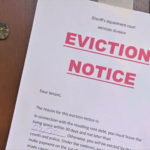A reference of Wisconsin eviction laws, and steps of the Wisconsin eviction process for landlords and renters, updated 2021.
- What are the reasons that landlords can evict tenants under Wisconsin eviction laws?
- Nonpayment of rent (Wis Stat. § 704.17(2)(a))
- Noncompliance of lease agreement (Wis Stat. § 704.17(2)(b))
- Tenant remains in possession of the rental unit after the lease term without the owner’s permission (Wis Stat. § 704.19(3))
- What notice do Wisconsin eviction laws require that landlords provide tenants before starting the eviction process?
- For evictions based on non-payment of rent, the landlord must provide a 5-day notice. However, if the landlord gave a 5-day notice previously and allowed the tenant to continue living there and the tenant is late on paying rent again, the landlord must provide a 14-day notice to the tenant. (Wis Stat. § 704.17(2)(a)).
- For evictions based on committing waste or non-compliance with a material term of the lease agreement, the landlord must provide a 5-day notice to the tenant. However, the landlord must provide a 14-day notice to the tenant if it is the second or subsequent violation within 12 months of the first violation. (Wis Stat. § 704.17(2)(b)).
- For evictions based on remaining in possession of the rental unit beyond the period of the lease without the owner’s permission, the landlord must provide at least 28 days’ notice. (Wis Stat. § 704.19(3)).
- Do Wisconsin eviction laws allow landlords to use “self-help eviction” methods, such as locking a tenant out of the rental unit or shutting off the utilities?
- No. Wisconsin law prohibits self-help measures, including excluding the tenant without following the eviction rules properly. (Wis Adm. Code ATCP § 134.09(7)).
Wisconsin Eviction Process: Step-by-Step
The eviction process in Wisconsin involves the following steps:
- The landlord serves the eviction notice. The landlord must provide the written notice to the tenant that states the reason for eviction and serve them with the notice. The tenant has five days to pay rent or cure non-compliance, if applicable. If the notice is the second notice, the landlord does not have to give the tenant an opportunity to fix it.
- The landlord files a complaint. If the tenant remains on the property, the landlord can begin the eviction process in Wisconsin by filing a Forcible Entry and Detainer action. To do so, the landlord files the following forms:
- Summons and Complaint – The landlord sets out the reasons why the eviction is valid and requests the court provide relief.
- Declaration of Nonmilitary Service Affidavit – The landlord prepares this document and submits it to the eviction complaint. It states whether the tenant is or is not on active military duty.
- The landlord serves the tenant. The landlord is responsible for serving the tenant with the Summons and Complaint. The tenant must be served at least five days before the hearing date. The landlord is responsible for ensuring an Affidavit of Service is submitted to the court as proof that the tenant was properly served.
- The tenant answers the complaint. If the tenant wants to contest the eviction, they file an Answer and Counterclaim.
- Parties attend the hearing. The parties attend the hearing indicated in the court papers. They each present their case to the court. The court rules in favor of one of them.
- The landlord receives a writ of restitution. If the court rules in the landlord’s favor, it gives a Writ of Restitution to the landlord. The landlord gives this form to the sheriff. The sheriff has ten days from receiving the writ of restitution to serve it on the tenant and physically remove them from the premises.







